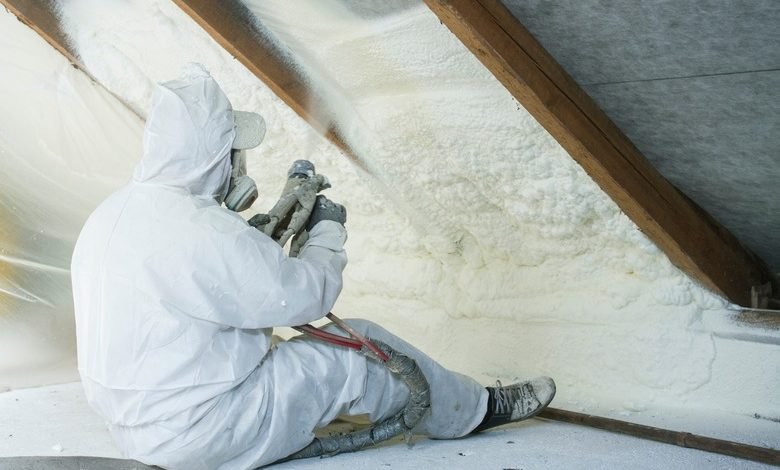Spray In Foam Insulation vs Blow In Insulation

There are many different home insulation options on the market these days. Two of the most popular are spray-in foam insulation and blow-in insulation. So, which one should you choose for your home? In this blog post, we will compare and contrast the two types of insulation, and help you decide which is the best option for you!
What is Spray-In Foam Insulation?
Spray-in foam insulation is a type of home insulation that is applied with a spray gun. The foam expands and hardens when it comes into contact with the surface, creating an airtight seal. This makes it an excellent choice for areas that are difficult to insulate, such as around pipes or in attics.
What are the benefits of using Spray-In Foam Insulation?
- Spray-in foam insulation is one of the most effective types of home insulation. It has a high R-value, which means it does an excellent job at blocking heat and cold from entering your home.
- Spray-in foam insulation is also very versatile. It can be used on a variety of surfaces, including wood, metal, and concrete.
- Spray-in foam insulation is also environmentally friendly. It is made from recycled materials and does not contain any harmful chemicals.
- Spray-in foam insulation is also very easy to install. You can do it yourself with a spray gun, or hire a professional to do it for you.
- Spray-in foam insulation is also very durable. Once it dries, it forms a hard, protective barrier that will last for years.
What are the drawbacks of using Spray-In Foam Insulation?
- One of the main drawbacks of spray-in foam insulation is that it is one of the more expensive home insulation options.
- Another drawback of spray-in foam insulation is that it can be difficult to remove if you ever need to access the area it was applied to.
- Spray-in foam insulation can also be messy to work with. It is important to wear protective clothing and goggles when applying it, and to make sure the area is well ventilated.
- Finally, spray-in foam insulation is not always the best choice for every home. If you have a home with a lot of pipes or ductwork, blow-in insulation may be a better option.
What is Blow-In Insulation?
Blow-in insulation is another popular type of insulation. It is made from a variety of materials, including fiberglass, cellulose, and rock wool. Blow-in insulation is applied using a special machine that blows the insulation into the desired area.
What are the benefits of using Blow-In Insulation?
- One of the main benefits of blow-in insulation is that it is very affordable.
- Blow-in insulation is also quick and easy to install. The machine does all the work for you, and it can be done in a matter of hours.
- Another benefit of blow-in insulation is that it does not off-gas like some other types of insulation. This means it is safe for you and your family to be around.
- Blow-in insulation is also environmentally friendly. It is made from recycled materials and does not contain any harmful chemicals.
- Finally, blow-in insulation is very versatile. It can be used in a variety of home sizes and types.
What are the drawbacks of using Blow-In Insulation?
- One of the main drawbacks of blow-in insulation is that it can be difficult to remove if you ever need to access the area it was applied to.
- Another drawback of blow-in insulation is that it does not always provide a tight seal. This means that there can be gaps and cracks where heat and cold can enter your home.
- Blow-in insulation can also be messy to work with. It is important to wear protective clothing and goggles when applying it, and to make sure the area is well-ventilated.
- Finally, blow-in insulation is not always the best choice for every home. If you have a home with a lot of pipes or ductwork, spray-in foam insulation may be a better option.
Given the benefits and the drawbacks, which insulation should you be getting for your home? The answer depends on a variety of factors, including the climate you live in, the type of home you have, and your budget. If you are unsure which insulation is right for you, it is best to consult with a professional. They will be able to assess your needs and make recommendations based on your specific situation.
Are you interested in getting home insulation? Get in touch with iFoam, the go-to company when it comes to insulation.
Factors to consider:
#1: The type of climate you live in
The answer to this question really depends on the climate you live in. If you live in an area with a lot of extreme weather, then it is important to choose an insulation that will be able to withstand the elements. For example, if you live in an area that gets a lot of snow and ice, then spray-in foam insulation would be a good choice. This is because it will not be affected by the moisture and will provide a tight seal. On the other hand, if you live in an area with milder weather, then blow-in insulation would be a better option. This is because it is less expensive and can be installed quickly and easily.
#2: Your budget
Another important factor to consider when choosing home insulation is your budget. If you are working with a limited budget, then blow-in insulation would be the best option. This is because it is less expensive and can be installed quickly and easily. On the other hand, if you have a larger budget, then spray-in foam insulation would be a better choice. This is because it will provide a better seal and will last longer. Usually, they cost about the same, but spray-in foam insulation will last longer, so it is worth the investment.
#3: The type of home you have
The type of home you have will also play a role in choosing the best insulation. If you have a home with a lot of pipes or ductwork, then spray-in foam insulation would be a better choice. This is because it will provide a better seal and will not be affected by the moisture. On the other hand, if you have a home with few pipes and ductwork, then blow-in insulation would be the better choice. This is because it is less expensive and can be installed quickly and easily.
So there you have it! Be sure to weigh in all the factors we discussed before making a final decision on which insulation to get for your home. If you are still unsure, it is always best to consult with a professional to assess your specific needs. They will be able to provide you with more detailed information and make recommendations based on your individual situation.





